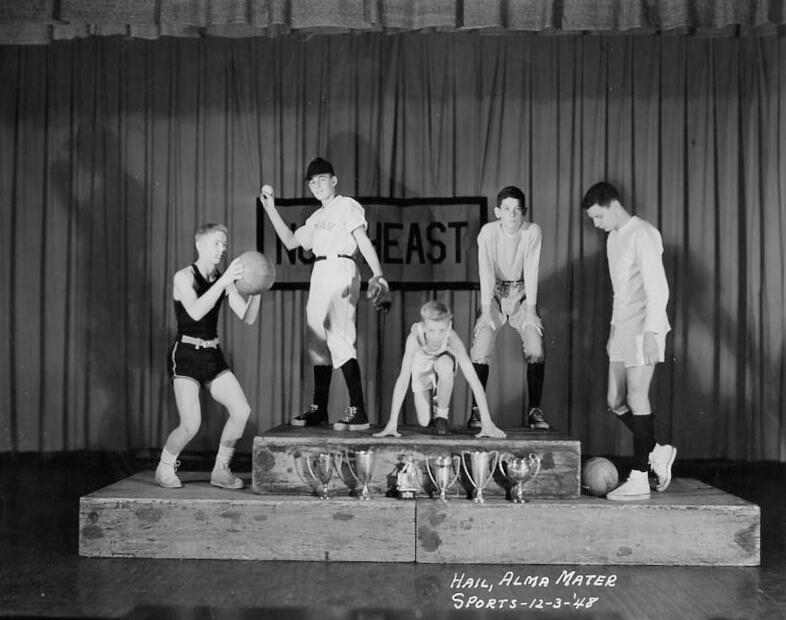
School Uniform: Gym and Sports Uniforms

Figure 1.--This is a tableaux from an American school in 1948. These living tableauxes were very popular in the early 20th century. We do not see many after World War II. The idea is to display the sports in which the school participates. The school seems to be Northeast. It surely is a private school because few American public high schools played soccer in the 1940s.
|
/td>
|
An important element of school uniforms and schoolwear is the gym uniform. Even schools that did not have school uniforms had gym suits as they were called in America. Here thre were initinally very substantial differences between boys and girls gym uniforms. One popular early gym uniform for girl was middy blouses, long bloomers, and long black stockings. We notice American girls wearing rompers for gym into the 1960s. Boys generally wore "T"-shirts and colored boxer shorts. In recent years differences between boys and girls gym uniforms have generally declined. Another trend has been dropping or cutting back on the physical education program. This is occiring at the same time juvenile obesity is becoming a serious problem. There were also a wide variety of sports uniforms. These uniforms have varied from school to school as well as from country to country and over time. Schools in American and Britain (especially the private scholls) as well as British Empire countries had strong spotys program. Other countries such as France had more strictly academic schools. We see a wide range of sports uniforms. This varied widely because the various sports unifirms were designed according to the demands of the sports.
Gym and pysical educatin in general was an inovation which developed during the 19th century in Europe and North America. Several educators in Europe began to promote the idea of physical education as a valuable part of the curricvulum. Colleges and Universities began to offer physical education programs throughout the the idea was gradually accepted at secondary and primary schools as well. In the United States, California was the first school to mandate physical education (1866). Over the next 30 years, the other states followed the California example. The actual physical education program has varied greatly over the years. A trend in recent years has been dropping or cutting back on the physical education program. This is occuring at the same time juvenile obesity is becoming a serious problem. An important element of school uniforms and schoolwear is the gym uniform or kit as it is called in Britain. Even schools that did not have school uniforms had gym suits as they were called in America. There were initinally very substantial differences between boys and girls gym uniforms. One popular early gym uniform for girl was middy blouses, long bloomers, and long black stockings. We notice American girls wearing rompers for gym into the 1960s. Boys generally wore "T"-shirts and colored boxer shorts. In recent years differences between boys and girls gym uniforms have generally declined.
There were also a wide variety of sports uniforms. The British use the term "games" meaning sports. These uniforms have varied from school to school as well as from country to country and over time. Schools in American and Britain (especially the private scholls) as well as British Empire countries had strong spotys program. Other countries such as France had more strictly academic schools. We see a wide range of sports uniforms. This varied widely because the various sports unifirms were designed according to the demands of the sports. Some of the most popular clothing worn by boys are sports uniforms. Organized sport for boys is a relatively recent phenomenon. Many modern sports have a history dating back to the 18th century or ealier. Organized professional teams attracting spectators and with uniformed players, however, did not appear until the 19th century. This was in part a result of the economic expansion of industrial Europe which generated increasing income and more leisure time. School teams began to be organized by British private schools after the mid-19th century. But organized youth sports for the most part are a 20th century development.
HBC-SU

Related Chronolgy Pages in the Boys' Historical Web Site
[Return to the Main Chronology Page]
[The 1900s]
[The 1910s]
[The 1920s]
[The 1930s]
[The 1940s]
[The 1950s]
[The 1960s]
[The 1970s]
[The 1980s]
[The 1990s]
[The 2000s]
Navigate the Relate Boys Historical Clothing Uniform Garment Pages
[Return to the Main garment page]
[Blazers]
[Bookbag]
[Caps]
[Coats]
[]
[Hose]
[Kilts]
[Pants]
[Shirts]
[Shoes]
[Smocks
[Suits]
[Sweaters]
[Ties]
Navigate the Boys' Historical Clothing School Uniform Country Pages
[Return to the Main sports page]
[Return to the Main School Uniform Page]
Return to the [Main National School Uniform Page]
[Australia]
[England]
[France]
[Germany]
[Ireland]
[Italy]
[Japan]
[New Zealand]
[Poland]
[Singapore]
[Scotland]
[Singapore]
[United States]
Navigate the Boys' Historical Clothing Web Page
[Introduction]
[Activities]
[Biographies]
[Chronology]
[Clothing styles]
[Countries]
[Bibliographies]
[Contributions]
[Essays]
[FAQs]
[Glossaries]
[Images]
[Links]
[Registration]
[Tools]
[Boys' Clothing Home]
Created: June 5, 1999
Last updated: 3:55 AM 2/4/2010




